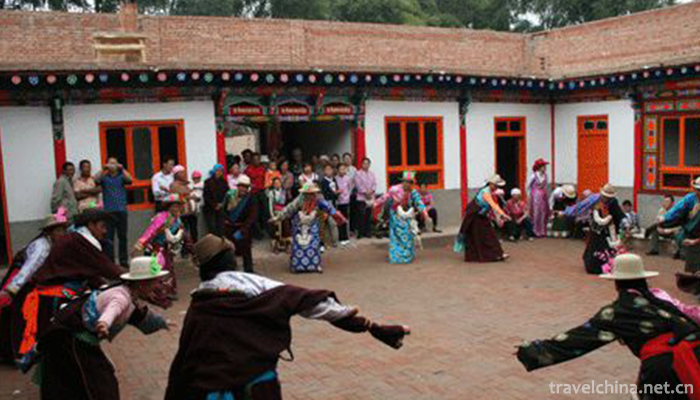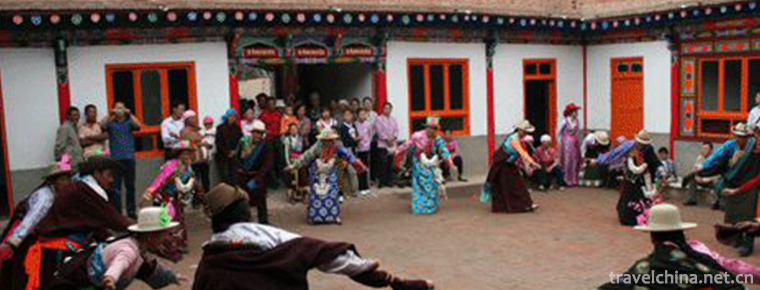Zerou
Zerou
Zerou (Shangyu Zerou), also known as Ashze, is a Tibetan folk dance in Guide County, Qinghai Province. Especially "Shangyu (Chinese: lower row) is soft" is the most important. They often perform at wedding, reception and other festive banquets.
On June 7, 2008, "Zerou" declared by Guide County of Qinghai Province was listed in the second batch of national intangible cultural heritage list with the approval of the State Council. Heritage serial number: 690 III-93.
historical origin
Overview
"Zerou" means play. Most of them perform at wedding, welcoming guests, birthday celebrations and other festive banquets. Zerou, who has been singing for more than 400 years in the locality, praises the infinite respect for his hometown and natural scenery in the way of singing and dancing. Because Asher has extensive mass participation and social foundation, his singing is inclusive in the course of hundreds of years'evolution. His tunes have developed from several initial tunes to more than 20 kinds. The structure and performance of his works have become more and more mature and become the classic of Asher's singing.
Origin and Evolution
Shang Youzerou, according to the investigation (according to the old artist Xiangxiu and Jiancuo), has a history of more than 400 years. It dances and sings, and its movements range from simple to complex. Since the beginning of several dances, it has developed to more than 20 kinds. Thirteen of them are relatively old. They are distributed in some Tibetan villages in Guide area. Shangyou is rich in content and variety, rich in lyrics and songs, simple and graceful movements, the original ecological potential remains intact, in Zerouli is more typical. Literary and artistic workers at home and abroad came to study and excavate one after another.
After the founding of the People's Republic of China, the people's government attached great importance to and supported it. Since the 1950s, Guide Shangyou has often performed in counties, prefectures and provinces. Especially since 1990, he has participated in many large-scale celebrations and square performances in Hainan. There are more than 80 performers in the cast. Shang Youzeru also performed in the large-scale Tibetan calendar celebrations held in the province.
Development characteristics
Songs are used to convey the message and assist in analogous movements.
According to historical records, Zerou originated in Xikang Aba area of Sichuan Province, and spread to Xiabai village of Guide in the mid-Ming Dynasty, and was gradually developed and promoted. It dances and sings, and its movements range from simple to complex. From only a few dances, to more than 20 kinds, of which 13 are relatively old. They are distributed in the Tibetan villages of Huangnan, Haibei, Hainan and Guide. The lower rank of Guide is more abundant in content, variety, changeable in lyrics and songs, more complex and graceful in action, and the original ecological potential remains intact, which is typical in "Zerou".
In Chinese, Shangyou means "lower row", referring to the lower row village of Hexi Town, Guide County, while gently means "play". Shangyou Zerou is a collective recreational activity. On New Year's Day, Tibetan girls wear their heads (when they are twelve, three or fifteen years old, they hold adult ceremonies for girls) and dance at wedding ceremonies. Most of the performances are performed in pairs of men and women, less than 2 people, up to 12 people, from both sides, or interlude, or dance, or line up in a circle, the scene changes at any time, rough and skilled movements, vivid and delicate metaphors, unrestrained expressions, warm atmosphere, giving the audience a feeling of comfort and happiness.
Zerou has a wide range of popularity and social foundation, unique style, rich performance, its variety, repertoire storage is large, ranking first in Tibetan dance, in Tibetan dance art has a wide range of representative and significant typicality. The ancient and profound connotation of Zeru embodies important academic value in anthropology, ethnology and folklore. At the same time, it has become a spiritual power with strong cohesion and motivation, and plays a unique role in the construction of modern spiritual civilization.
artistic characteristics
basic content
1. To eulogize justice softly, to eulogize the happy working scenes of the Tibetan people and the national customs of singing and dancing. He also praised the fattening harvest of cattle and sheep in the pastoral areas, whipping evil.
2. Zerou usually sings at festivals, Tibetan girls wearing their heads (when they are eleven, thirteen or fifteen years old) and Tibetan wedding ceremonies.
3. When performing, there are fewer than two couples of men and women, up to hundreds of people. They appear on both sides, or interlude, or dance, or line up in a circle. The scenes change at any time. The metaphor is vivid and delicate, the melody is beautiful and the atmosphere is warm, which gives the audience a feeling of comfort and happiness.
Main features
1. The combination of rituality, performance and self-entertainment has attracted the participation and attention of all walks of life. It has a broad public and social foundation and has reached a higher level in content and art.
2. It plays an important role in the minds of the Tibetan people. It is the symbol of spirit and dignity as well as the carrier of personality and emotion.
3. Shangyou Zerou is a collective recreational activity, which is inherited by the mass way. The best performances are lead dancers, lead dancers, old dancers lead new dancers, and so on, and get a wide range of dissemination.
4. Shangyou Zeru's performance can be divided into two kinds: solemnity and arbitrariness. The solemnity has a fixed time and place. The arbitrariness can be performed and jumped at any time regardless of time and place.
5. Shangyou Zerou is an art combining sound, dance and words, performing in the form of singing and dancing. Language is gorgeous, quintessential and full of literary color.
Shangyou Zerou's dance movements are vivid and delicate, and the original ecological situation remains intact. It has distinct characteristics and wide representativeness in Tibetan dance.
Inheritance and Protection
Inheritance value
1. Shangyou Zerou has distinct characteristics and diversified varieties. Shangyou Zerou has a wide range of representativeness and remarkable typicality in Tibetan dance, and has special value in understanding and promoting Tibetan dance culture.
2. Shangyou Zerou is the most representative dance of pastoral style. It is the manifestation of Tibetan people's profound thoughts and bold personality. It is well-known both inside and outside the province for its rich performance, unique style and exquisite skills. Therefore, it has unique value in researching and promoting Zerou culture and art of Tibetan nationality.
3. As Shangyou Zeru has a long history, Shangyou Zeru contains many ancient cultural information. Because of the development process of the ancient Tibetan people carried by Shangyou Zeru, Shangyou Zeru has important value in anthropology, ethnology, folklore and other research.
4. Shangyou's soft position is sacred and has wide influence. It has become a spiritual motive force with strong cohesion and motivation. Therefore, it can become a brand in the construction of modern spiritual civilization and play a unique role.
Repertoire
1. Deer Dance
2. Ajoma
3. Milk-promoting music
4. Anzhao
Inheritance pedigree
1. Heritage inheritance: old artist Lane Show (deceased), Huajia (deceased), Jigao, Pengmaozhuma, Ramao.
2. Entertainment inheritance: In wedding and festival performances, old artists teach young people.
3. Training and inheritance: Shangyou Zeru Performance Team was set up in Xiabai Village in the early liberation period, relying on the performance team for training and inheritance. Celebrations, competitions, and training of literary and artistic performances. Later, the ethnic school hired Shangyou as a soft artist, and carried on Shangyou as a soft inheritance in the school.
Current situation of inheritance
Facing the strong impact of modern culture, Rou is facing a severe crisis of survival, which can be seen as follows:
1. Well-known artists and important dance backbone have died one after another, some of them are old and frail, while the growth of new backbone forces is slow, creating a very fragile cultural environment for new well-known artists, and the phenomenon of artists and important backbone fault is emerging.
2. Because of the artists'fault and the loss of original ecological art concept, Shangyou Zeru's artistic style has become more and more distorted, resulting in the loss of original style, original characteristics and original cultural artistic conception.
3. As people become more and more indifferent to the vividness of Shangyou Zeru, from the original public participation to a few people's simple performances, Shangyou Zeru's cultural space becomes narrower and narrower, so that it eventually enters an endangered situation.


-
1.Ning Xia Night Market
Ningxia Night Market is one of the few night markets in Taipei ...
Time 2018-10-12 -
2.waterless rice noodle
Bait silk is one of the special snacks in Yunnan. It is mainly made from rice
Time 2018-10-17 -
3.The Simatai Great Wall
Simatai Great Wall is located in the north of Simatai Village, Gubeikou Town, northern Miyun District, Beijing. It is adjacent to Gubeishui Town. The wall of Simatai Great Wall is built on the steep m
Time 2018-12-10 -
4.Shangrao Lingshan Scenic Area
Shangraolingshan Scenic Area, located in the north of Shangrao County, Shangrao City, Jiangxi Province, is a national scenic spot with an area of 160 square kilometers. Lingshan is listed as the "
Time 2018-12-19 -
5.Helan Mountain Rock Painting
Helan Mountain Rock Painting is a national key cultural relics protection unit, the national AAAA level tourist attractions, the national research tourism demonstration base (2016 one of the first 20)
Time 2019-01-13 -
6.Wuhan Revolutionary Museum
The Wuhan Revolutionary Museum is located at No. 13 Hongxiang, Wuchang, Wuhan, Hubei Province. It was merged by the memorial hall of the former site of the Wuchang Peasant Movement Workshop
Time 2019-02-24 -
7.Eight treasures tomato
Blanch the tomatoes with boiling water, peel them off, dig a round piece along the pedicle one week, remove the seeds and wash them. Cut all the accessories into small dices, mix shrimps and meat with
Time 2019-03-25 -
8.Hua gu deng Flower drum lantern
Flower drum lantern, a traditional dance in Bengbu City, Fengtai County and Yingshang County, Anhui Province, is one of the national intangible cultural heritage.
Time 2019-05-04 -
9.Firing Techniques of Jizhou Kiln Ceramics
Jizhou kiln is a treasure of the traditional Chinese ceramic crafts. As a world-famous comprehensive ceramic kiln in Jiangnan (Ji'an, Jiangxi), it has strong local style
Time 2019-05-05 -
10.Qianjiang Folk Songs
Qianjiang folk song is a traditional folk song in Hubei Province. Popular in Qianjiang City, folk songs created by local working people in their work, life and customs. Its rich content,
Time 2019-06-10 -
11.Taoping Qiang Village
Taoping Qiang village is located in Taoping Township, beside Zagunao River in Lixian County. Qiang village is 40 km away from Lixian City, 16 km from Wenchuan city and 139 km from Chengdu. It is a national key cultural relics protection unit and an important scenic spot in Jiuhuang line tourism circle.
Time 2020-11-07 -
12.Deyang City Construction
In January 2020, the science and Technology Department of Sichuan Province and the provincial development and Reform Commission approved to support Deyang and other six cities to carry out the construction of provincial innovative cities.
Time 2020-12-14